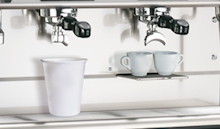Are More Group Heads Better Than One? If your just starting up in the wonderful world of serving coffee to your customers and about to purchase your first espresso machine, then hopefully the advice and guidance provided here should prove valuable and even money saving towards making your final decision and that grand purchase.


When deciding how many group heads you'll need, the first question you need to ask yourself is "how many covers will I have to serve?" the answer to that question is the best starting point and pretty easy to answer:
Based on the standard serving of a 30ml espresso shot we have the following table
I know it looks from the table above that 240 espressos per hour from a 1 group looks like it could service 250 covers, but espresso quotes from manufactures don't allow for the machine having to produce steam for milk, and also the hot water for Americanos, hence a 1 group would only serve 40 covers in the real world.
Also remember that not everyone coming into to your establishment will want to drink a lovely cappuccino (although we wish they would right), you also serve a wide range of other drink options to cater to all your customers wishes and whims.

How many steam arms you might need on your espresso machine might seem a little strange, but lots to consider here. A good starting point is to make sure that your new machine does come with 2 steam arms. You never know when you might want to remodel your shop, and the espresso machine could end up being located up against a side wall, having steam arms at both ends of the machine will mean that you still have at least one usable steam arm.
I know that we have talked about 'auto frothers' in another article, but love them or hate them, sometimes having the option could be right for you. If you think you'll have a lot of transient staff that could lack the required skill level, then having an auto froth option on the machine would be a great asset.

Are you planning to serve Take Away cups? then having a machine with raised group heads would be a must. Most manufactures now offer versions of their espresso machines to cater for the talll sizes of paper take away cups. Different manufactures have approached this issue in various ways and formats
Having the raised groups avoids having to dispense the espresso into a small jug and then pour this into the take away cup. On the other side of the coin, if your purely restaurant based, then low group heads mean you don't have to mess about switching trays or playing around with shelves for your standard cappuccino cup.
So a really big machine is a must for your operation.. a better path to go down would be to buy 2 separate 2 group machines and 2 grinders. Believe it or not, this variant will give you way more flexibility, both for how you operate the machines and how your staff can work on the machines.
A typical 3 or 4 group machine will require around 6000w to operate and have an average 17ltr boiler. A standard 2 group machine will be 3000W with an 11ltr boiler, so 2 x 2 groups will still give you a total 6000w but with 22lts of boiler capacity for the really busier periods, along with the following benefits:
Another point to bear in mind as you purchase your machine, is your hot water requirements. Salesmen will tell quite happily that your sparkling new espresso machine will be all singing all dancing and be able to provide all your needs, including hot water for tea.
One problem with drawing hot water from your machine for tea usage is that is at the wrong temperature for tea and really should only be used for its designed purpose of coffee. If you've looked at how the espresso boiler works, you will see that when you draw hot water from the machine, it refills the boiler with cold water:
A much better option is to always allow space to fit a dedicated hot water boiler. This will take some of the work away from the espresso machine and will also allow you to brew tea at the optimum temperature. You also end up with a back facility to serve alternative beverages, just in case the espresso machine does breakdown.
This is the big one. We all know that we can shop around and buy from the net at sometimes super discounted prices. But remember that your buying a very important piece of kit to earn your livelihood and that there are certain PSSR Health & Safety laws related to the installation of pressure vessels.
Regardless of the price that the machine cost, it will at some point breakdown and require an engineer to fix it and get you up and running as quickly as possible. Having a good local specialist company supply and install your espresso machine will give you valuable back-up in the future.
Talking local, don't skimp on the price of the coffee beans, the coffee is generally the last thing a customer will taste before leaving your restaurant. Again a local coffee roaster will be able to offer knowledgeable help and advise, and also ensure that that your machine and grinder are set up correctly for that bean.
